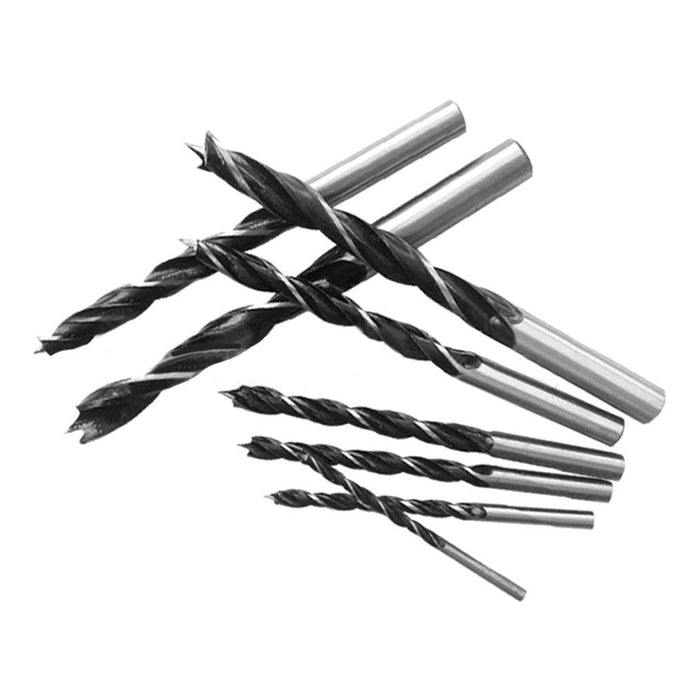When it comes to drilling holes, selecting the right tool for the job is essential for achieving clean, accurate results. Among the many options available, two types of drill bits stand out for their unique designs and purposes: the brad point drill bit and the regular (or twist) drill bit. While both are widely used in a variety of applications, understanding the differences between them can help you choose the best bit for your project, whether you're working with wood, metal, or other materials. In this article, we will compare brad point and regular drill bits in terms of design, performance, and the types of tasks each is best suited for.
The most significant difference between brad point and regular drill bits lies in their design. A brad point drill bit features a sharp, pointed tip at the center, often resembling a small nail or "brad." This center point is designed to provide greater control when starting a hole, ensuring the bit stays exactly where it's intended, without wandering. Surrounding the central point are two main cutting edges that help remove material from the hole. The brad point bit's design is particularly effective in wood, as the pointed tip allows for precise placement, while the cutting edges create a smooth hole with clean entry and exit points.
In contrast, a regular drill bit - also known as a twist drill bit - has a more conventional, spiral design. The bit features a pointed tip, but it lacks the sharp center point that a brad point bit has. Instead, regular drill bits rely on the two spiraling flutes that run along the length of the bit to both guide the drill and remove material from the hole. These spiral flutes allow for efficient material removal but do not offer the same level of control at the start of drilling, especially when working with materials like wood, where the bit may wander or slip. Regular drill bits are commonly used in a variety of applications, from drilling into wood and plastic to metal and masonry, thanks to their versatile design and broad compatibility with many materials.
One of the key advantages of a brad point drill bit - Findbuytool is its ability to create highly accurate, clean holes in wood and wood-based materials like plywood and MDF. The sharp center point digs into the material as soon as the bit makes contact, ensuring the hole remains centered and preventing the bit from veering off course. This is particularly useful when working with delicate or finished wood, where even slight imperfections at the entry or exit points can be visible. Brad point bits also tend to produce less splintering and tear-out compared to regular drill bits, which is a significant advantage when making clean, aesthetically pleasing holes for projects like cabinetry or fine furniture.
On the other hand, regular drill bits are more versatile and perform well in a wide range of materials, including metal, plastic, and masonry. Their spiral flute design allows them to clear away debris quickly and efficiently, making them ideal for drilling into tougher materials. When drilling through wood, however, regular drill bits may cause more splintering or rough edges, particularly on the underside of the hole. The lack of a centered point means that regular bits can wander a bit at the start, leading to inaccuracies, especially on smooth or softwood surfaces.
In terms of performance, the brad point drill bit excels when precision is key. It's the go-to choice for woodworkers who need to drill accurate holes for dowels, joinery, or decorative tasks. The center point ensures that the bit starts exactly where it's supposed to, while the cutting edges produce clean, well-defined holes with minimal mess. Brad point bits are also less likely to cause the bit to wander or "walk" across the wood, which is especially beneficial when drilling small holes or holes in thin materials.
However, regular drill bits are better suited for more general-purpose tasks, especially when working with harder materials like metal or concrete. Their spiral design allows for efficient material removal and faster drilling, making them ideal for tough jobs that require power and speed. Regular bits are also more durable in these tougher applications, as their design is meant to handle higher pressures and temperatures. For those working with a wide variety of materials or those who need a versatile drill bit for different tasks, a regular drill bit is a more practical choice.
When it comes to cost, regular twist drill bits tend to be more affordable and are often sold in bulk, making them a more economical option for everyday use. Brad point bits, on the other hand, tend to be slightly more expensive due to their specialized design and the precision they offer. However, for anyone who regularly works with wood or requires high-accuracy drilling, the investment in a quality brad point bit is well worth it.
In conclusion, both brad point and regular drill bits have their place in the toolbox, and choosing the right one depends on the materials you're working with and the type of task you're performing. Brad point bits excel in woodworking, offering superior precision, clean holes, and minimal splintering. They are ideal for projects that require accuracy, like furniture building or cabinetry. Regular drill bits, on the other hand, offer more versatility and are the better choice for general-purpose drilling into a wide range of materials, including metal and masonry. Understanding these key differences will help you select the right drill bit for every job, ensuring you get the best performance and results every time.
